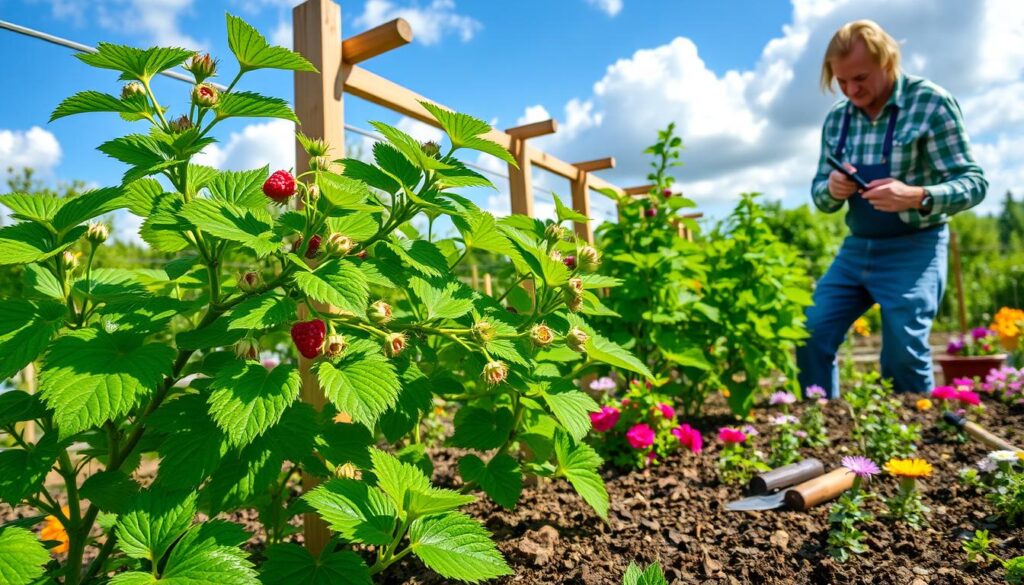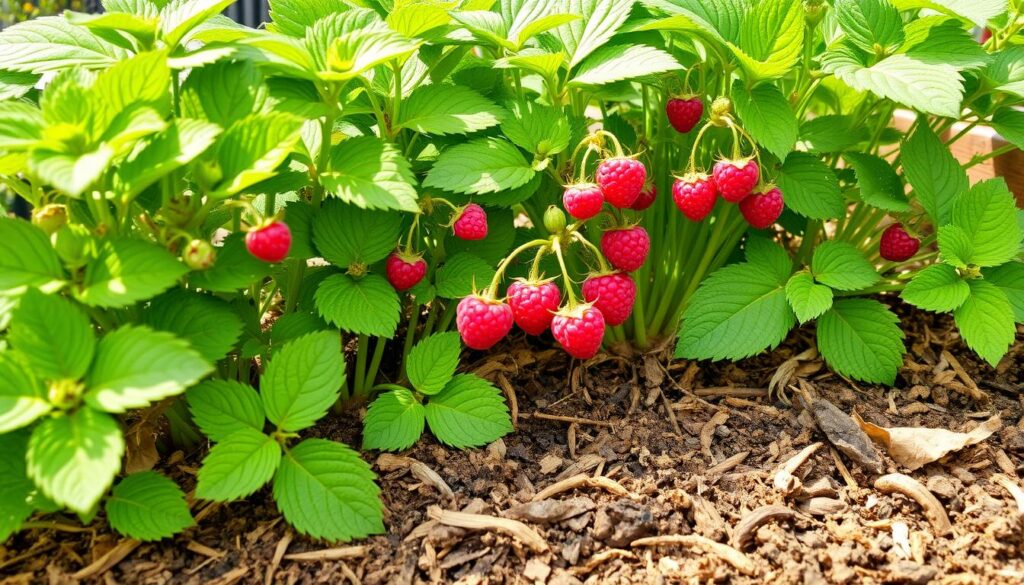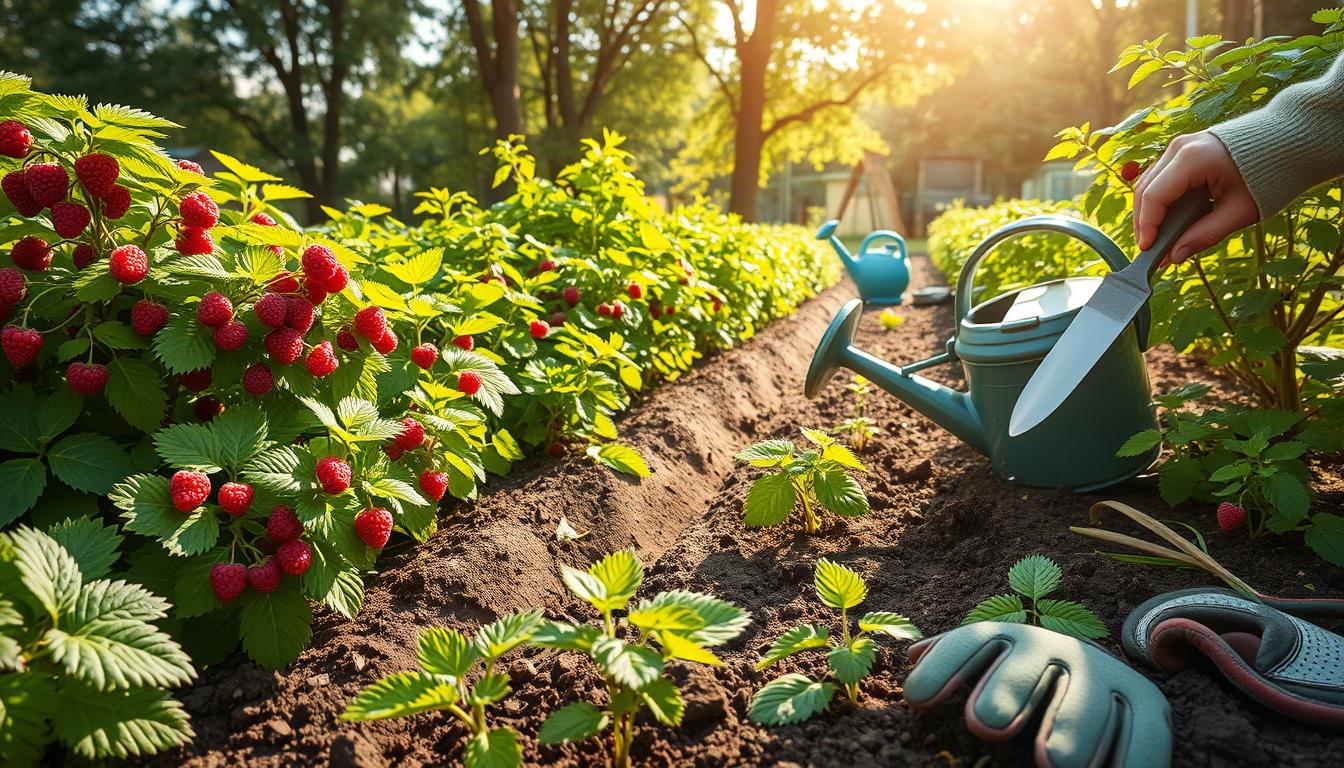Welcome to my comprehensive raspberry planting guide! Growing raspberries in your backyard is rewarding. These fruits are easiest to grow and thrive in many climates. They can produce lots of sweet berries from just one plant.
Proper care means your plants will bear fruit in just a year. In this guide, I’ll share everything you need to know. This includes the best varieties, planting conditions, and maintenance tips.
It’s important to know the difference between summer and fall-bearing raspberries. Also, make sure your plants get full sun, good drainage, and plenty of air. Whether you want a big raspberry patch or just to enjoy your harvest, I’ve got you covered. I’ll share my own experiences and expert advice. Join a community like Garden Beginner for more tips and tricks. Let’s explore raspberry maintenance for a bountiful harvest!
Key Takeaways
- Raspberries thrive in full sun and produce fruit within a year of planting.
- Common varieties include red, black, and purple raspberries.
- Pruning in March helps prepare red and yellow raspberries for growth.
- Effective watering, mulching, and pruning maximize raspberry yield.
- Monitor for pests like spider mites and Japanese beetles during summer.
- Harvest ripe raspberries every couple of days for optimal freshness.
Introduction to Growing Raspberries
Growing raspberries is a rewarding hobby that brings sweet and nutritious fruit. Gardeners love them for their taste and versatility in cooking. Learning raspberry growing tips is key to growing these tasty berries.
Knowing the basics of raspberry care is crucial. Raspberries grow well in cooler climates and are easy to care for. They don’t need another plant to produce berries, but more plants can increase the yield. They do best in moist, well-drained soil with organic matter.
Homegrown raspberries are cheaper than store-bought ones. They save money and let you enjoy pesticide-free fruit. Plant them two feet apart in rows and eight feet between rows for good air flow. A sunny spot is best to keep plants healthy and productive.
Following good raspberry care instructions helps your plants thrive. There are summer and fall-bearing varieties, each with its own needs. With the right care, growing raspberries is a fun and rewarding experience.
Choosing the Right Raspberry Varieties
Choosing the right raspberry varieties is key to a successful garden. Knowing the difference between summer-bearing and ever-bearing raspberries is important. Each type grows differently and has its own harvest time.
Summer-bearing raspberries grow on last year’s canes and produce fruit in warmer months. Ever-bearing raspberries give two harvests: one in fall and another the next summer. This is great for gardeners who want more berries.
Understanding Summer-Bearing vs. Fall-Bearing Raspberries
Summer-bearing raspberries focus on last year’s growth for fruit. They usually bear fruit in June or July. Ever-bearing raspberries, or fall-bearing raspberries, produce fruit on new growth. This means a longer harvest season.
Many gardeners love the chance to pick berries in autumn and the next summer. Varieties like Polana and Caroline are great for this double harvest with the right care.
Recommended Varieties for Your Garden
When picking raspberry varieties, think about your local climate and what you like. Here are some top picks:
| Variety | Type | Hardiness Zone | Flavor Profile |
|---|---|---|---|
| Polka | Ever-bearing | 4–5 | Excellent flavor, large firm fruit |
| Heritage | Summer-bearing | 3-8 | Medium-sized, very vigorous |
| Caroline | Ever-bearing | 4–8 | Excellent flavor, dense canes |
| Nova | Summer-bearing | 4–5 | Very good flavor, gradual ripening |
| Anne | Ever-bearing | 4-5 | Unique flavor, large fruit |
These varieties are perfect for many growing conditions, including zone 4. By picking the right variety, I get delicious flavors and plenty of berries for years. Raspberries can even produce for up to 20 years, making my choice a long-term investment.
How to Plant and Grow Raspberries
To grow raspberries well, you need to know the best ways to care for them. When and where you plant matters a lot. Plant raspberry canes in early spring when the soil is soft. This helps with drainage and makes sure they get enough sunlight.
Best Planting Time and Location
Finding the right spot is key for growing raspberries. They love full sun and spreading out. Don’t plant them where potatoes or tomatoes grew before, as these can spread diseases. Raspberries grow best in zones 3 to 10, depending on the variety.
Preparing the Soil for Raspberry Plants
Good soil is essential for raspberries. Add compost or aged manure to make the soil richer. Test the soil first to make sure it drains well. Raised beds help with drainage in wet areas.
Planting Techniques for Raspberry Canes
Planting raspberry canes right is important for their growth. Space them 3-4 feet apart, with 1.8 meters between rows. Dig deep holes for the roots. Cut the canes back to encourage new growth. These steps help your raspberries thrive.
For more tips and a raspberry planting guide, my research shows following these steps leads to a bountiful harvest.
Essential Raspberry Growing Tips
Caring for raspberry plants needs attention to details, especially watering schedule for raspberries and mulching. These steps are key for healthy growth and good yields. Using the right raspberry growing techniques can improve your harvest quality.
Watering and Nutrient Requirements
Raspberries do best with steady moisture from spring to harvest. They need about 1 to 1.5 inches of water each week. In summer, keeping this moisture is vital. In winter, water less.
I’ve found that a good watering schedule for raspberries and regular feedings from spring to early July help. This leads to healthier plants and more fruit.
Mulching and Weed Control Methods
Mulching around raspberry plants is very helpful. Using 2-3 inches of organic mulch keeps soil moist and stops weeds. Straw, wood chips, or grass clippings are good mulching materials.
It’s also important to watch for weeds and control them. This keeps your plants healthy and productive. A good weed control plan helps your plants get the resources they need.
| Watering Schedule | Nutrient Requirements | Mulching Benefits |
|---|---|---|
| 1-1.5 inches weekly | Fertilize spring to July | Maintains moisture |
| Reduce in winter | Use balanced fertilizer | Reduces weed growth |
| Monitor for dryness | Optimal nitrogen supply | Improves soil health |
For more gardening tips, check out my disclaimer on how I share these tips openly.
Pruning and Training Raspberry Plants
Keeping raspberry plants healthy needs regular care in pruning and support. Following the right steps boosts berry production and plant health. Summer and fall-bearing raspberries have different pruning needs for strong growth.
When and How to Prune Raspberries
Pruning raspberries every year is key for both types. For primocane varieties, cut canes to the ground in late fall or early spring. This keeps plants tidy and encourages new growth and fruit.
Floricane varieties need more work. Cut spent canes to the ground in late fall or early spring. Young canes should be pruned to 4-5 feet tall for better fruiting. Black raspberries benefit from tip pruning when shoots are 3 feet tall.
Setting Up Trellises for Support
A sturdy trellis system helps raspberries grow and gets more sunlight and air. For floricane varieties, use multiple wires at different heights. Rotating cross-arm trellises make harvesting easier.
In high tunnels, primocane raspberries can grow 8 feet tall. Good trellising is crucial for their health. It makes maintenance easier and improves light for better berry production. These steps lead to healthy plants and plenty of berries.
Seasonal Care for Raspberry Plants
It’s important to care for raspberry plants all year round. Each season has its own needs, especially in spring, summer, and winter. I focus on spring maintenance for raspberries, summer raspberry care, and winter prep.
Spring Care and Maintenance
Spring is key for raspberry growth. I make sure the plants get enough water and check the soil moisture. I water deeply, letting the soil soak up 1″-2″ of water weekly.
I also give them a balanced liquid fertilizer, especially to container plants. This helps them grow strong.
Summer Care and Pest Control
In summer, seasonal raspberry care means watching out for pests. I check my plants for spider mites and Japanese beetles often. Keeping the plants clean and using insecticidal soaps helps fight pests.
It’s also crucial to water correctly. Containers need daily water, while landscape plants get watered about two to three times a week.
Preparing Your Raspberries for Winter
When winter approaches, it’s time to prepare. I use mulch to keep the roots warm and the soil temperature stable. I wait until early spring to prune, cutting dead canes to the ground.
Even though raspberry bushes are hardy, I protect plants in decorative containers. This prevents damage from wildlife and helps them make it through winter.

Harvesting Raspberries Successfully
Knowing when to pick your raspberries is key to getting the sweetest ones. I’ve learned that knowing the raspberry harvest times for my garden’s varieties has boosted my harvest. Summer-bearing raspberries are best in mid-summer, while fall-bearing ones are ready in late summer. Watching your berries grow helps you timing your raspberry harvest perfectly.
When to Harvest Raspberries
Raspberries are at their best when they’re a deep pink-red. They quickly change from small, white ovaries to full berries. They usually ripen in 4 to 5 days after they start to form. I watch the weather, as dry days help them ripen better. Picking in dry weather keeps them firm and less likely to get damaged.
Techniques for Picking Ripe Berries
When harvesting raspberries, be gentle. They’re delicate and come off the stem easily when ripe. Pick them when they’re dry and warm to avoid bruising. After picking, I handle them carefully to keep them fresh.
Need more help with raspberries? Check out my contact page for more tips and advice.
Common Pests and Diseases in Raspberry Gardens
Knowing about raspberry pests and diseases is key for gardeners. Pests and diseases can harm plant health and reduce yields. Spotting problems early is crucial for managing them.
Identifying Potential Problems
Raspberry gardens face many challenges. Aphids, Japanese beetles, and fruitworms can weaken plants and spoil fruit. Fungal diseases like powdery mildew and botrytis fruit rot are common. These diseases spread through rain or irrigation, showing the need for careful water use.
Cane diseases, such as anthracnose and cane blight, can severely damage canes. This leads to lower yields. The common issues in raspberry cultivation also include leaf distortions from diseases like raspberry leaf curl virus (RLCV). Symptoms like dropping leaves or soft brown fruit spots help in early detection.
Preventive Measures and Solutions
Managing pests and diseases in raspberries starts with prevention. Regularly check plant health, keep the area clean, and use the right watering methods. Organic fungicides, like sulfur and Bacillus subtilis, can fight powdery mildew well. Prune infected canes and improve air flow to prevent fungal diseases.
Using resistant plant varieties, like ‘Latham’ and ‘Killarney’, is a good strategy for disease control. Raspberries need well-draining soil with a pH of 5.5 to 6.5 to avoid root rot. Environmental factors like humidity and temperature also play a big role in disease prevention. Applying fungicides at the right time and keeping plants healthy are essential.
| Disease/Pest | Causes | Symptoms | Prevention Measures |
|---|---|---|---|
| Botrytis Fruit Rot | Botrytis cinerea | Soft, brown areas on fruit | Avoid overhead watering, apply fungicides |
| Powdery Mildew | Podosphaera aphanis | White powder on leaves | Regular inspections, use organic fungicides |
| Cane Blight | Leptosphaeria coniothyrium | Purple-black cankers on young canes | Pruning and maintaining good air circulation |
| Raspberry Leaf Curl Virus | Aphid transmission | Curling leaf margins | Management of aphid populations |
Best Practices for Raspberry Cultivation
Keeping the right conditions for raspberry growth is key to a successful garden. Good soil health is crucial for strong roots and plenty of fruit.
Maintaining Healthy Soil Conditions
Raspberries need slightly acidic soil, with a pH between 5.5 and 6.5. Testing the soil helps me know if I need to add anything. Adding compost, rich in manure, makes the soil better at holding nutrients and water.
Here are some key steps to improve soil for raspberries:
- Regularly test soil pH and amend as needed.
- Incorporate compost to boost organic matter.
- Avoid clay soil, which hampers drainage.
- Ensure raspberries are planted in well-draining soil to prevent root rot.
- Mulch to retain moisture and suppress weeds.

Managing Raspberry Growth and Spread
It’s important to manage raspberry canes well for their growth and fruit production. Without control, raspberries can grow too close together, affecting fruit quality and making them more prone to disease. I prune regularly to keep them in check and prevent too many suckers.
To manage raspberry spread, I follow these steps:
- Thin out canes each spring, removing weak or overcrowded shoots.
- Monitor for suckers and remove as necessary to maintain air circulation.
- Space raspberry canes at least 18 inches apart to allow for proper growth.
- Run support wires between T-posts every 5-8 feet to stabilize canes.
- Prune second-year canes to the ground after harvesting to encourage new growth.
By focusing on soil health and managing raspberry growth, I get a great harvest and healthy plants.
Conclusion
Looking back, my journey in raspberry gardening has been rewarding. I’ve learned how to pick the best varieties and plant them right. I’ve also found out how to keep the soil just right for them.
This knowledge has let me enjoy picking and eating fresh raspberries. The tips I’ve gathered help me get more berries and make them taste even better. This is great for eating them fresh or for making other treats.
Season after season, I’ve taken good care of my raspberries. I prune them, keep pests away, and do other maintenance tasks. This hard work has paid off, giving me lots of berries.
Places like Washington, Oregon, and California show that hard work really pays off. By choosing the right raspberries, like Heritage and Caroline, my garden grows well. It gives me lots of fruit to enjoy.
Raspberry gardening is full of ups and downs. But with the right knowledge, it’s also very rewarding. I’ve not only gotten better at gardening but also helped support local farmers.
As I keep gardening and sharing what I learn, I see the value of growing our own food. Every time I pick raspberries, I remember the hard work and love I put into my garden. It’s a special feeling.



Leave a Reply